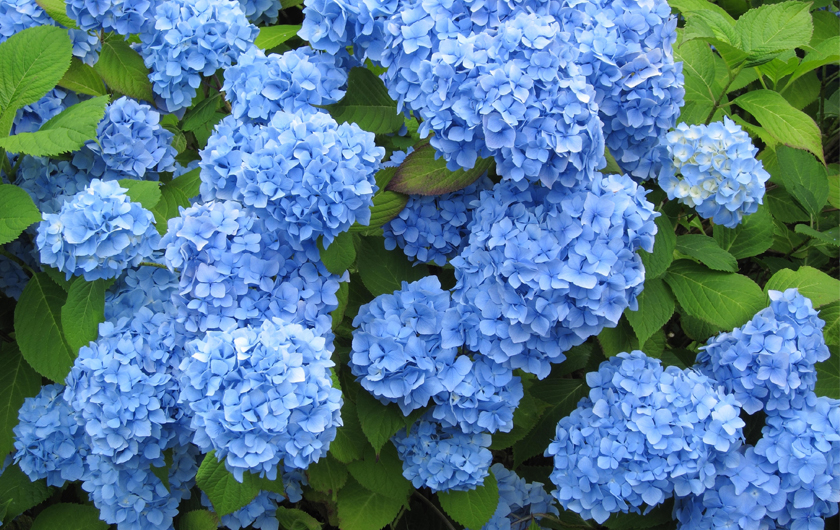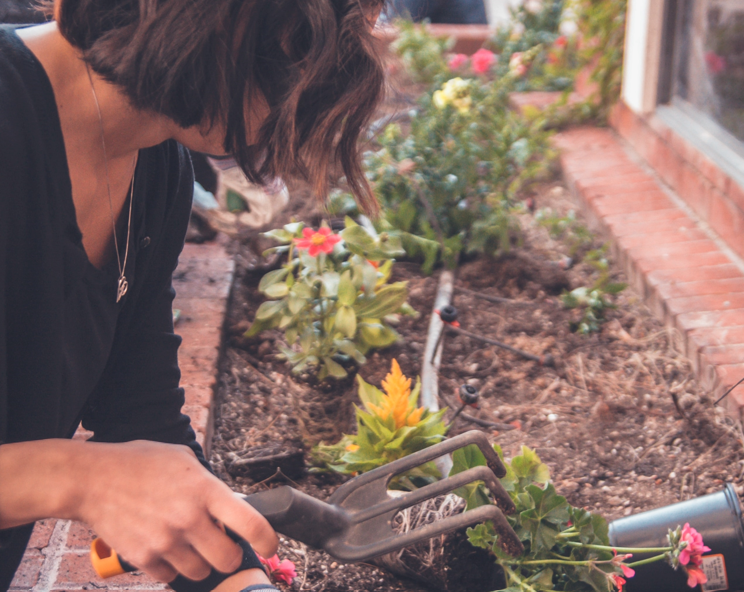In late May and early June, you’ll find that Mother Nature is especially fond of wearing blue
By Carol Hall
Hydrangea macrophylla ‘Nikko Blue’; photo: Carol Hall.
Mother Nature is choosy about the colours of her seasonal wardrobes. In late winter/earliest spring, she dresses almost exclusively in yellows and purples, with accents of pink and white. In fall, she goes for the red/orange/yellow palette, adding a few bronzes and burgundies here and there. In mid-spring, she wears a seemingly unlimited array of colours, although she does tend to favour pastel shades. In midsummer, she throws caution to the wind and mixes and matches bright colours with abandon. In between these two riotously coloured seasons, however, from late May to early July, she has a noticeable preference for one colour: blue.
There are physical and biological reasons for the occurrence of certain colours at certain times—the amount of sunlight available for photosynthesis, temperature levels, the wavelengths and frequencies of the colour spectrum most likely to attract pollinating insects—but it’s tempting to think that Mother Nature, like us, simply needs a visual break from so much colour and has chosen her cool, calming, serene blue shades for that reason alone.
Be that as it may, her seasonal blues provide a garden-refreshing interlude in the most beautiful way imaginable. To the everlasting benefit of gardeners, she provides every shade from soft mauve to dusky blue to blue-violet to pale blue to midnight-blue to sky-blue to sapphire-blue on a variety of perennials, ground covers, and shrubs, as well as annuals. Choosing blue flowers in June is pure delight: the sky’s the limit.
Bellflowers
Among the most reliable and versatile blues for the June garden are bellflowers (Campanula species, most hardy to -40°C/F). Good choices include tall cutting-garden species such as peach-leaved bellflower (C. persicifolia, China blue) and clustered bellflower (C. glomerata ‘Superba’, dark purple-blue), as well as ground-cover types such as Carpathian bellflower (C. carpatica ‘Blue Chips’, medium blue) and fairy thimble (C. cochleariifolia, light blue; ‘Elizabeth Oliver’ has double flowers like tiny rosettes). For larger spaces, let ground-hugging Dalmatian bellflower (C. portenschlagiana, mauve-blue) spread or allow the taller, more rampant Serbian bellflower (C. poscharskyana, violet-blue) to romp freely.
Clematis
The clematis types that belong to Pruning Group B (large flowers that bloom in May, June, and September; prune only for shaping and repair in late winter) include many excellent blue shades. Just a few include ‘Blue Light’ (pale blue, double), ‘Blue Ravine’ (soft violet-blue), ‘General Sikorski’ (mauve with white stamens), ‘H. F. Young’ (soft mauve-blue), ‘Lasurstern’ (mid-blue with white stamens), ‘Mrs. P.T. James’ (light blue, double), ‘Sally Cadge’ (mid-blue with carmine stripes), and ‘Will Goodwin’ (lavender-blue with ruffled edges). All are hardy to -35°C/-30°F.
Hardy Geraniums
Hardy to -40°, knee-high cranesbills or hardy geraniums—not to be confused with the popular bedding plant—are another good source of June blues. Meadow geranium (Geranium pratense, light lavender-blue), Himalayan geranium (G. himalayense, violet-blue with rosy veins), and showy geranium (G. x magnificum, deep violet-blue with darker veins) are all excellent choices, but long-venerated Johnson’s Blue geranium (G. ‘Johnson’s Blue’) still can’t be beat for its large flowers of clear mauve-blue.
If the somewhat lax stems of ‘Johnson’s Blue’ are a problem, look for newer, sturdier but slightly less hardy (to -35°C) hybrids that approach its wonderful colour, such as ‘Brookside’, ‘Orion’, and Rozanne (‘Gerwat’).
Hydrangeas
Bigleaf hydrangea (Hydrangea macrophylla, to -29°C/-20°F) has long been famous for blue flowers in both its forms: mophead forms (large round clusters of sterile flowers) and lace-caps (disk-shaped flower heads with a ring of sterile flowers surrounding tiny fertile flowers). Interestingly, an individual plant will produce blue flowers if the soil is strongly acidic and pink flowers if the soil is strongly alkaline.
To guarantee blue flowers, aluminum sulphate (available at garden centres) should be added to the soil several months before the plant blooms. ‘Nikko Blue’, long the standard for blue mopheads, is quite large (1.8 m/6 ft. tall and wide); for smaller gardens, look for ‘Blue Bonnet’ or ‘Penny Mac’. Compact lace-caps are also available, but the massive ‘Mariessii Perfecta’, sold as Blue Wave, remains unchallenged for colour.
Since the flower buds of H. macrophylla are formed the previous summer, they can freeze in winter at -18°C/0°F even though the plant itself is unharmed. Luckily, a breeding breakthrough has resulted in a compact variety that forms buds in spring, as well, so that flowers are guaranteed even in winters as cold as -35°C. Sold as Endless Summer (‘Bailmer’), it comes in several colours, but again, whether the flowers are blue or pink depends on whether the soil is acidic or alkaline.
Challenging Blues
Seen and remarked on everywhere in coastal southeastern British Columbia when its blue flowers burst into bloom in June, the evergreen shrub known as California lilac (Ceanothus thyrsiflorus) would be a real challenge to grow elsewhere in Canada: it’s hardy only to -12°C/10°F and dislikes hot, humid summers. Within its limited range, though, the large, slightly hardier (to -18°C) cultivar ‘Victoria’ thrives easily. Its numerous small bottlebrush-type flowers, beloved by bees, are actually mid-blue but appear dark blue against the glossy green foliage.
While easy to grow for one or two seasons, the evergreen, mat-forming ground cover Lithodora diffusa ‘Grace Ward’ (hardy to -23°C/-10°F) is finicky about drainage (must be excellent), soil (must be acidic), and moisture (must be abundant), and its leaves turn black in drought, severe cold, or high heat. However, its eye-popping sapphire-blue flowers make it worth growing even as an annual.
Gentians (Gentiana species) and Himalayan blue poppies (Meconopsis betonicifolia) are the twin Holy Grails of blue flowers, and any gardener who can grow them consistently deserves a medal. Although both perennials are hardy to -40° in a cool, moist site with good drainage, both are notoriously fickle. But their heart-stopping flowers (gentian’s trumpet-shaped flowers are deep true blue; Himalayan blue poppy is sky-blue) keep thousands of gardeners trying every year. It’s no wonder: once seen, nobody can resist joining the quest.






